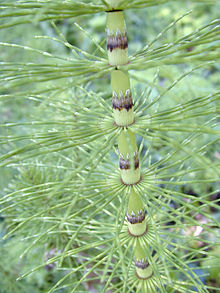- Equisetum arvense
-
Field Horsetail 
Equisetum arvense Scientific classification Kingdom: Plantae Division: Pteridophyta Class: Equisetopsida Order: Equisetales Family: Equisetaceae Genus: Equisetum Species: E. arvense Binomial name Equisetum arvense
Linnaeus, 1753Equisetum arvense, commonly known as the Field Horsetail or Common Horsetail, is a rather bushy perennial with a rhizomatous stem formation native to the northern hemisphere. These horsetails may have sterile or fertile stems. Sterile stems start to grow after the fertile stems have wilted. The sterile stems tend to be much taller and bushier, with the jointed segments being around one inch (2.5 cm) long with a diameter of about 1/20th of an inch (1 mm). These segments contain one set of whorled, slender, erect branches each. Some stems can have as many as 20 segments and be as tall as 2-24 inches (5–60 cm). The fertile stems tend to be half as tall as the sterile stems and also tend to be more succulent.
This plant also has a very high diploid number - 216 (108 pairs of chromosomes) - which is roughly 5 times greater than the human diploid number (46).
Uses
The plant contains several substances which can be used medicinally. It is rich in the minerals silicon (10%), potassium, and calcium.[citation needed] The buds are eaten as a vegetable in Japan and Korea in spring time. All other Equisetum species are toxic. In polluted conditions[citation needed], it may synthesize nicotine.[1] Externally it was traditionally used for chilblains and wounds.[2] It was also once used to polish pewter and wood (gaining the name pewterwort) and to strengthen fingernails. It is also an abrasive. It was used by Hurdy-Gurdy players to dress the wheels of their instruments by removing resin build up.[3]
It is used in biodynamic farming to make the "silica" soil preparation.[clarification needed] (BD 508) Equisetum in particular is used because silicon reduces the effects of excessive water around plants that would lead to fungus. It is the high percentage of silica in the plant that works on lowering the impact of moisture.[4]
Invasive species
E. arvense was introduced into New Zealand in the 1920s and has been classed as an invasive species since the mid 1990s.[5] It is listed on the National Pest Plant Accord preventing its sale, spread and cultivation.
References
- ^ Bebbington, A. "Toxicity of Equisetum to Horses". omafra.gov. http://google.com/scholar?q=cache:gsPgCQilHXMJ:scholar.google.com/+equisetum+nicotine&hl=en&as_sdt=2000. Retrieved 1 December 2010.
- ^ Howard, Michael. Traditional Folk Remedies (Century, 1987); p.159-160
- ^ La Vielleuse Habile, Jean-Francois Bouin, 1761, page 19.
- ^ Kearny, Peter. "Bio Dynamic Prep 508". Bio Dynamic Prep 208. City Food Growers. http://cityfoodgrowers.com.au/bd508.php. Retrieved June 2011.
- ^ Howell, Clayson (May 2008). Consolidated list of environmental weeds in New Zealand. DRDS292. Wellington: Department of Conservation. ISBN 978-0-478-14413-0. http://www.doc.govt.nz/upload/documents/science-and-technical/drds292.pdf. Retrieved 2009-05-06.
External links
- "E. arvense". Integrated Taxonomic Information System. http://www.itis.gov/servlet/SingleRpt/SingleRpt?search_topic=TSN&search_value=17152.
- E. arvense at Germplasm Resources Information Network (GRIN)
- E. arvense at eFlores.org
- Une entreprise en procès pour avoir commercialisé de la prêle (French)
- Horsetail at Medline
- Field Horsetail at Biosecurity New Zealand
Categories:- Equisetum
- Invasive plant species
- Medicinal plants
- Garden plants
- Fern species
- Flora of North America
Wikimedia Foundation. 2010.

